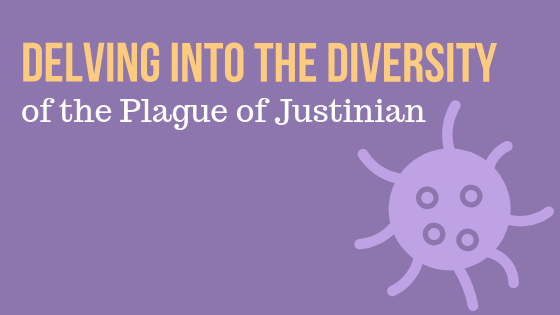Human teeth play a key role in our understanding of how organisms evolve. Whenever a possible new member of the hominid family is uncovered, the shape and number of teeth are used to place that individual in the family tree. Teeth also harbor information about pathogens that have plagued humans for millennia. Because bacteria use our bloodstream as a transport system, protected places that can preserve DNA—like the pulp of teeth—are a rich medium for uncovering information about humans and the microbes that infected them.
Written by: Sara Klink, PRomega
Teeth have been the choice for identifying the infectious agent behind the Plague of Justinian in the sixth century and the Black Plague in the 14th century. In fact, Yersinia pestis, the bacterium responsible for these plagues, has infected humans as far back as the Neolithic. But what can we learn about the pandemic strain or strains of Y. pestis described in historical records? A team of researchers from Europe and the US, many of whom have been delving into the history of Y. pestis for the last decade, wanted to further investigate the Plague of Justinian. They studied bacterial DNA extracted from human remains found in Western European communal graves that were dated to around 541–750, the period of the historically documented Plague of Justinian. Their investigation examined the bacteria’s diversity and how far it spread during this “First Pandemic” of plague.
Finding the Bacterial DNA
In this PNAS report, Keller et al. extracted DNA from teeth of 121 individuals and screened for the presence of pla, the gene present on the Y. pestis-specific plasmid pPCP1. Of the 20 sites in Western Europe that were dated ∼300– 900 CE, eight sites were positive for Y. pestis, located in present-day Germany, France, Spain and Britain. The ancient bacterial DNA was treated with uracil-DNA-glycosylase (UDG) to minimize DNA damage and used to create libraries for Y. pestis enrichment and subsequent sequencing. To eliminate false positive results, any sequences that were low coverage for the Y. pestis chromosome and did not have sequences that mapped to the Y. pestis plasmids were eliminated.
Comparing the New Sequences with Existing Data
How do these eight new Y. pestis samples compare to previously sequenced genomes, including ones that were part of the initial analysis for the Plague of Justinian? Researchers performed single nucleotide polymorphism (SNP) analysis to explore the relationships among the genomes. Each time a phylogenetic (“family”) tree has been created for Y. pestis, the differences in SNPs are the basis for placing each member on a branch of the tree. In addition, a new tool called SNPEvaluation was developed by Keller et al. to ensure stringent analysis so that low sequence coverage or disagreements around the SNP region would not produce false positive results. A total of 49 SNPs (44 chromosomal SNPs, three pCD1 plasmid SNPs and two pMT1 plasmid SNPs) were found across the 11 genomes with 39 of the chromosomal SNPs that could distinguish among the strains for phylogenetic analysis.
Putting Together the Family Tree
If these genomes are from the same time period, the Y. pestis strains should cluster together on their family tree and agree with the previously sequenced Plague of Justinian genome. In fact, they do. However, the genomes are not identical because the DNA was isolated from different places and different time windows. For example, the British strain has a unique SNP that places it earlier on the tree than those from France, but the two French strains found in two different locations also split from each other. However, none of these genomes are associated with modern strains.
Comparing Pathogenic Regions Among Pandemic Strains
Were there any differences in the genes or regions associated with virulence in First Pandemic Y. pestis compared to the those from the Second (Black Death) and Third (modern era) Pandemics? The strains from France from two different locations had deletions in magnesium transport genes, which play a role in Y. pestis survival in macrophages. Interestingly, these genes were part of a larger 45kb deletion that encompassed chemotaxis and motility genes, a region that was also deleted in two Second Pandemic strains, one from Britain and one from France. But in the 20 Y. pestis strains surveyed, no other showed this 45kb deletion.
Conclusion
So what did we learn from these new Y. pestis strains that arose during the First Pandemic? Like strains from the Black Death, the older bacterial strains no longer exist except in the remains of those who likely died from them in the past. Intriguingly, two different genomes were recovered from the same site in France, a first for any of the ancient Y. pestis strains. The authors hypothesize that either there were two unrelated strains in a single outbreak or that population was struck twice in an interval. Unfortunately, the burial site cannot resolve which possibility occurred. The team isolated a strain from southern Germany despite no reports of plague in that location. In addition, finding Y. pestis in a sixth century burial in Britain is earlier than written records indicated.
Paleogenomic studies like the one in this PNAS article highlight how DNA analysis can complement archeological and historical information to offer a more complete picture of what occurred in the past. As researchers plumb the depths of ancient DNA, we may learn more about this scourge that has infected humans for millennia, and discover insights that can be applied to modern infectious agents. All this from humble teeth.
Reference
Keller, M. et al. (2019) Ancient Yersinia pestis genomes from across Western Europe reveal early diversification during the First Pandemic (541–750). Proc. Natl. Acad. Sci. USA. 116, 12363–72. doi: 10.1073/pnas.1820447116.
WOULD YOU LIKE TO SEE MORE ARTICLES LIKE THIS? SUBSCRIBE TO THE ISHI BLOG BELOW!
SUBSCRIBE NOW!


